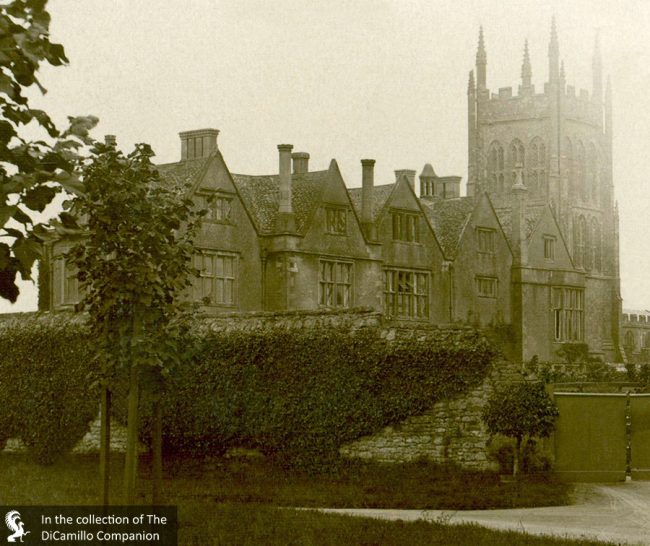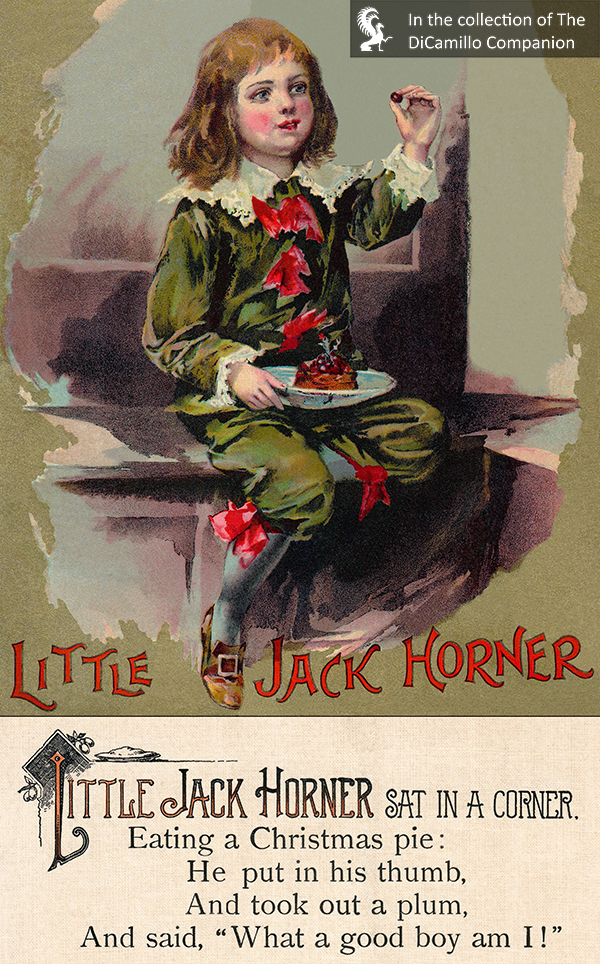
The house from a 1916 postcard. The 15th century tower of St. Andrew's Church is on the right.

1898 illustration from "Gems from Mother Goose"
House & Family History: Mells was originally a grange of Abbot Selwood of Glastonbury. Mells Manor was supposedly acquired by Jack Horner, who discovered the deed in a pie given to him to carry to London. Jack was actually John Horner, steward to Richard Whiting, the last abbot of Glastonbury Abbey. Legend has it that, prior to the abbey's destruction by Henry VIII's minions, the abbot sent Horner to London with a huge Christmas pie which had the deeds to a dozen manors hidden within it and that, during the journey, Horner opened the pie and fished out the deed of Mells Manor. (The manor's properties included lead mines in the Mendip Hills, thus the phrase "he pulled out a plum," which comes from the Latin "plumbum," i.e., lead). It is upon this tale that the popular nursery rhyme "Little Jack Horner" is based (see "Images" section). This story is very likely a myth; what probably occurred was that, after the Dissolution of the Monasteries, the house was purchased in 1543 by Thomas Horner. Thomas bequeathed it to his nephew, Sir John Horner, who married Merial Malte, the heiress of John Malte, tailor to Henry VIII. Sir John and his son Thomas considerably enlarged the manor, leaving it a spacious house. Circa 1770-80 the north and central sections of the house were demolished to provide stone for the stable courtyard at Mells Park House. The remaining south wing was used during the late 18th and early 19th centuries as a dower house, a farmhouse, and, between 1850 and 1860, as a vocational school. In the early 20th century Sir John and Lady Horner returned to their ancestral home and restored it as their principal seat. The Horners were friends with Sir Edwin Lutyens, who provided designs for the gardens and the house's Music Room. Mells Manor is today a seat of the Asquith family. The house was visited by Charles I and his troops in 1644 during the English Civil War.
Garden & Outbuildings: The circa 1520 walled garden was partially redesigned circa 1900 by Gertrude Jekyll and Edwin Lutyens. The park inspired Falls Park in Thomas Hardy's short story, "The First Countess of Wessex," published in the 1891 in "A Group of Noble Dames."
Chapel & Church: The Grade I-listed St. Andrew's Church is located next to the house (see "Images" section). The 15th century Perpendicular style church, which replaced an earlier church on the site that was owned by Glastonbury Abbey in the 13th century, was restored in the 19th century. There is a fine, large memorial in St. Andrew's to Edward Horner, who died in the Battle of Cambrai in 1917 during World War I. The equestrian statue of Horner was designed by Sir Alfred Munnings and sits on a base designed by Edwin Lutyens. The church also contains a large (almost eight-feet-tall) bas-relief gesso tablet on the north wall of the west tower that depicts a peacock (which represents resurrection) standing on a laurel tree that was designed in 1886 by Edward Burne-Jones as a memorial to his friend Laura Lyttleton, who died in childbirth the same year. In 1886 Burne-Jones created a colored, gilt gesso on wood copy of the Lyttleton memorial that the artist kept in his London home (it is today in the collection of the Victoria and Albert Museum). In addition to members of the Horner family, the poet Siegfried Sassoon and the politician Sir Maurice Bonham-Carter (grandfather of the actress Helena Bonham-Carter) are buried in the churchyard.
Architect: Edwin Landseer Lutyens
Date: Circa 1905-25Architect: Gertrude Jekyll
Date: Early 20th century
Title: Buildings of England: North Somerset and Bristol, The
Author: Pevsner, Nikolaus
Year Published: 1958
Reference: pg. 226
Publisher: London: Penguine Books
ISBN: NA
Book Type: Hardback
House Listed: Grade I
Park Listed: Grade I
Current Seat / Home of: Raymond Benedict Bartholomew Michael Asquith, 3rd Earl of Oxford and Asquith
Past Seat / Home of: Thomas Horner, 16th century; Sir John Horner, 17th century; Sir John Francis Fortescue Horner, until 1927; Katharine Frances Asquith (née Horner), 1927-76; Sir Julian Edward George Asquith, 2nd Earl of Oxford and Asquith, 1976-2011.
Current Ownership Type: Individual / Family Trust
Primary Current Ownership Use: Private Home
House Open to Public: No
Historic Houses Member: No